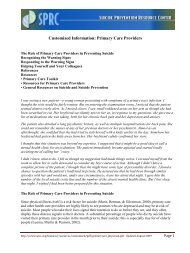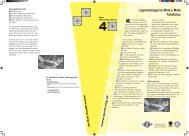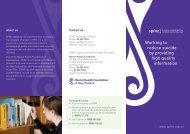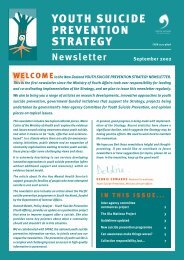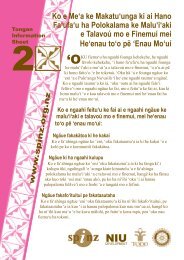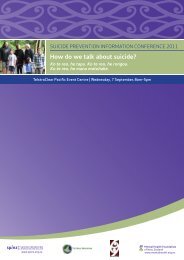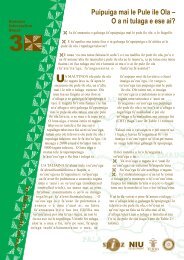A background document to support Kia Piki Te Ora O Te ... - SPINZ
A background document to support Kia Piki Te Ora O Te ... - SPINZ
A background document to support Kia Piki Te Ora O Te ... - SPINZ
Create successful ePaper yourself
Turn your PDF publications into a flip-book with our unique Google optimized e-Paper software.
THE RELATIONSHIP BETWEEN CULTURE AND BEHAVIOUR<br />
It has been found that cultural alienation is a valid explanation for indigenous experiences of being at higher<br />
‘risk’ for drug and alcohol abuse, mental health problems including depression and suicide, and other adverse<br />
behaviours. 26 Eckersley identifies that culture can provide a sense of belonging and purpose, a sense of<br />
meaning and self-worth and a moral framework <strong>to</strong> guide conduct. 27 Similarly, Skegg et al. link the cultural<br />
alienation of young Mäori <strong>to</strong> increased suicide risk. 28<br />
La Due confirms a relationship between cultural identity and alcoholism for Native American women, noting<br />
that the loss of cultural ties and values contributes <strong>to</strong> Indian alcoholism, and that women who are away from<br />
their traditional centres of <strong>support</strong>, be it familial, spiritual or communal, appear <strong>to</strong> be at a higher risk for<br />
alcohol abuse. 29<br />
Durie maintains that a secure Mäori identity will act <strong>to</strong> protect against poor health even in the presence of<br />
adverse socio-economic conditions. This finding has been derived from preliminary results of the Hoe Nuku<br />
Roa: Mäori Profiles research project in which it has been identified that Mäori in the study associate a secure<br />
identity with ‘a sense of being Mäori and access <strong>to</strong> cultural markers such as whänau, Mäori land, knowledge<br />
of ances<strong>to</strong>rs, Mäori language and opportunities <strong>to</strong> associate with other Mäori people.’ 30<br />
To date, theories about the impact of cultural loss on individual Native American behaviour has placed<br />
indigenous individuals along an acculturation continuum. According <strong>to</strong> this approach, the outcomes of<br />
colonisation present as behaviours that collectively indicate the extent <strong>to</strong> which the individual has been<br />
alienated from their identity as Native American. This is measured according <strong>to</strong> the degree of traditionality<br />
or acculturation that is manifest in the behaviour of the individual.<br />
Metcalf proposes a cultural cultivating model in the treatment of Native American women for alcoholism. 31<br />
Taking the notion of a traditional <strong>to</strong> acculturated continuum, Metcalf broadens the theory by proposing that<br />
many Native Americans are neither grounded in their traditional culture nor acculturated in<strong>to</strong> the dominant<br />
culture. 32 According <strong>to</strong> Metcalf, the assumption that client characteristics vary only along a traditional <strong>to</strong><br />
acculturated continuum fails <strong>to</strong> recognise the heterogeneity of indigenous populations. In treatment terms, the<br />
cultural cultivating model recognises that any form of intervention with Native Americans must recognise<br />
the various realities of Native Americans and adopt a mix of approaches in the treatment process. 33<br />
In research on indigenous youth suicide in the United States, it was found that although high suicide rates<br />
have been associated with drug and alcohol abuse, high unemployment, child abuse and neglect, less<br />
traditional tribes have higher rates of suicide than traditional tribes. 34 The reason for this is thought <strong>to</strong> be<br />
related <strong>to</strong> a greater sense of belonging and greater <strong>support</strong> of adolescents. 35<br />
In terms of local analyses of the interface between culture and behaviour, in the development of guidelines<br />
for the purchase of mental health services for Mäori, Durie et al. identify many of the same themes that<br />
have been recognised in the development of <strong>Kia</strong> <strong>Piki</strong> <strong>Te</strong> <strong>Ora</strong> O <strong>Te</strong> Taitamariki. 36 Those themes are directly<br />
relevant <strong>to</strong> practices that they term cultural affirmation. These include recognising the relationship between<br />
culture and health, and confirming the importance of cultural inputs in<strong>to</strong> mental health programmes such as<br />
cultural assessment, whänau participation, use of Mäori language, tikanga Mäori, karakia, rongoa, Mäori<br />
leisure pursuits, involvement of <strong>to</strong>hunga or traditional healers and a Mäori workforce.<br />
A REVIEW OF EVIDENCE: KIA PIKI TE ORA O TE TAITAMARIKI – THE NEW ZEALAND YOUTH SUICIDE PREVENTION STRATEGY<br />
Thompson identified consumer and whänau preferences in mental health services. 37 The results were similar<br />
in that whänau participation, recognition of Mäori spirituality and cultural engagement were seen as central<br />
<strong>to</strong> effective mental health services for Mäori.<br />
Further, in the consensus development conference on the treatment of people with drug and alcohol problems<br />
it was agreed that health and sickness of any kind are inseparable from spiritual and whänau well-being. 38<br />
These are cultural determinants of well-being for Mäori.<br />
PAGE 11



